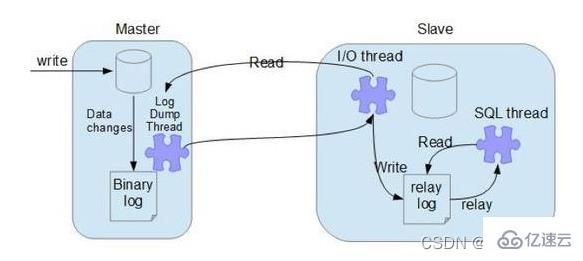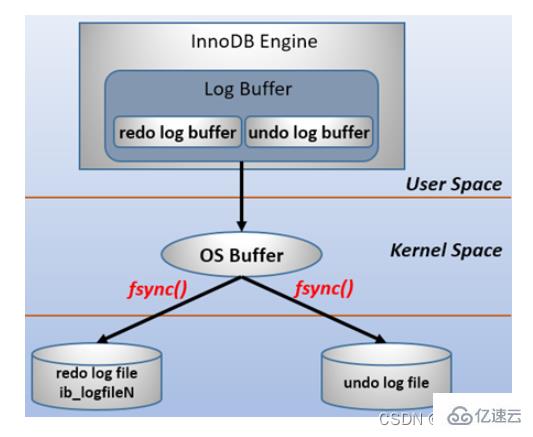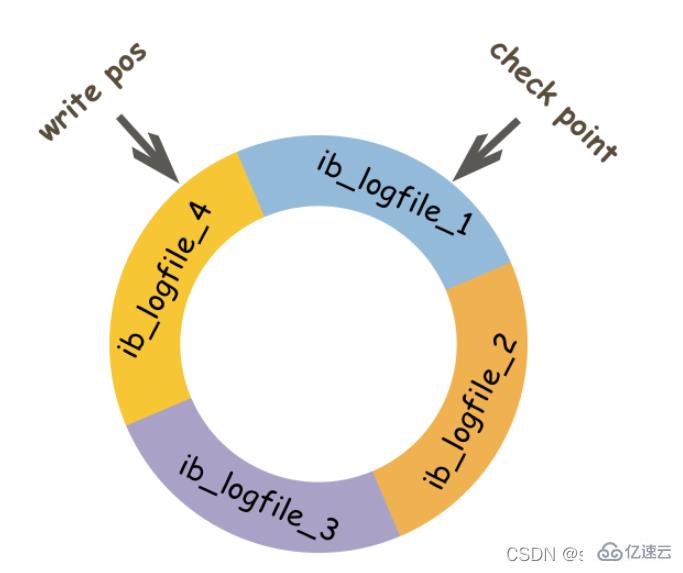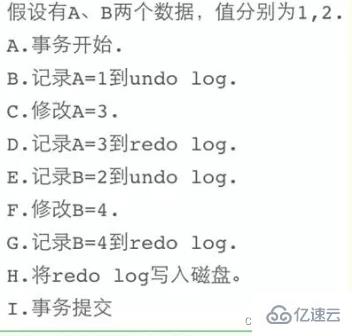How to use MySQL's binlog, redo log and undo log

1. Binlog
Binlog is used to record information about write operations performed in the database. It excludes query operations and is saved on disk in binary format. . Binlog is the logical log of mysql and is recorded by the server layer. Mysql databases using any storage engine will record binlog logs.
Logical log: can be simply understood as a sql statement;
Physical log: The data in MySQL is stored in the data page. The physical log records changes on the data page; insert the code snippet here
The binlog is written by appending, and the size of each binlog file can be set through the max_binlog_size parameter. , when the file size reaches the given value, a new file will be generated to save the log.
binlog usage scenarios
Project In actual applications, there are two main usage scenarios for binlog, namely master-slave replication and data recovery.
Master-slave replication: Enable binlog on the Master side, and then send the binlog to each Slave side. The Slave side replays the binlog to achieve master-slave data consistency.
Data recovery: Recover data by using the mysqlbinlog tool.
MySQL master-slave synchronization principle

- ##Master node binlog dump thread
When the slave node connects to the master node, the master node will create a log dump thread to send the contents of the binlog. When reading operations in the binlog, this thread will lock the binlog on the master node. When the read is completed, the lock will be released even before launching to the slave node;
- Slave node I/O thread
When the start slave command is executed on the slave node, the slave node will create an I/O thread to connect to the master node and request the updated binlog in the master library. After the I/O thread receives the update from the master node binlog dump process, it saves it in the local relaylog;
- Slave node SQL thread
The SQL thread is responsible for reading the relaylog The content is parsed into specific operations and executed, ultimately ensuring the consistency of master-slave data;
MySQL database master-slave synchronization principle
binlog content As mentioned above, binlog is a logical log, which can be simply understood as a sql statement, but in fact it also contains the reverse logic of the executed sql statement. delete corresponds to delete itself and the reverse insert information; update contains information about the data rows before and after the corresponding update is executed; insert contains its own insert and corresponding delete information.
binlog format There are three binlog formats, namely statement, row and mixed. Before MySQL 5.7.7, statement was used by default, and after MySQL 5.7.7, row was used by default. The format of the log can be modified through binlog-format in the my.ini configuration file.
(1) Statement: Statement-based replication (SBR) based on SQL statements. Each SQL statement that modifies data will be recorded in the binlog.
- Advantages: No need to specifically record changes in a certain row, saving space, reducing IO, and improving performance;
- Disadvantages: When executing sysdate( ) or sleep() and other operations, it may lead to inconsistency between master and slave data;
- Advantages: The details of each row record modification are recorded in great detail, so there will be no situation where the data cannot be copied correctly;
- Disadvantages : Since the details of each record modification will be recorded in great detail, a large amount of log content will be generated. Assume that there is an update statement and many records are modified. Each modified record will be recorded in the binlog. In particular, for the alter table operation, due to changes in the table structure, each row of records will change, resulting in a sudden increase in log volume;
In particular, as mentioned above, the new version (after MySQL 5.7.7) uses the row format by default. The row here has also been optimized accordingly. When encountering the alter table operation, the statement format is used for recording. The rest Operations still use row format.
binlog flushing timing
For the InnoDB storage engine, the binlog will only be recorded when the transaction is submitted. At this time, the record is still in the memory, and MySQL passes sync_binlog controls the flushing timing of binlog. The value range is 0-N:0: It is not forced to flush to the disk, and the system will decide when to write to the disk;
1: The binlog must be written after each submission. Write to the disk;
N: Every N transactions, the binlog will be written to the disk;
As can be seen from the above , the safest setting for sync_binlog is 1, which is also the default value for MySQL versions after 5.7.7. However, setting a larger value can improve database performance. Therefore, in actual situations, you can also increase the value appropriately and sacrifice a certain degree of consistency to obtain better performance.
Physical file size of binlog
You can control the size of binlog by configuring the max_binlog_size parameter, which is located in the my.ini configuration file. The system will create a new file to continue to store logs when the size of the log exceeds the capacity limit of the binlog file. What should I do when a transaction is relatively large, or when there are more and more logs, and the physical space it occupies is too large? MySQL provides an automatic deletion mechanism, which can be solved by configuring the expire_logs_days parameter in the my.ini configuration file. The unit is days. When this parameter is 0, it means it will never be deleted; when it is N, it means it will be automatically deleted after the Nth day.
2. redo log
redolog is the proprietary log system of the InnoDB engine. It is mainly used to achieve transaction durability and crash-safe functions. Redolog is a physical log, which records the specific modifications on the data page after the SQL statement is executed.
We all know that when MySQL is running, data will be loaded from disk into memory. When a SQL statement is executed to modify the data, the modified content is actually only temporarily saved in the memory. If the power is cut off or other circumstances occur at this time, these modifications will be lost. Therefore, after modifying the data, MySQL will look for opportunities to flush these memory records back to the disk. But there is a performance problem, mainly in two aspects:
InnoDB interacts with the disk in data units of pages, and a transaction may only modify a few bytes on a page. , if a complete data page is flushed back to the disk, it will waste resources;
A transaction may involve multiple data pages. These data pages are only logically continuous but not physically continuous. Use random IO The performance is too poor;
Therefore, MySQL designed redolog to record the specific modifications made to the data page by the transaction, and then flush the redolog back to the disk. You may have doubts. Originally, I wanted to reduce io. Wouldn’t this add another io? The designers of InnoDB have taken these into consideration at the beginning of the design. Redo log files are usually small, and sequential I/O is used during disk flushing. Better performance compared to random I/O.
Basic concepts of redo log
Redolog consists of two parts, one is the log cache redo log buffer in the memory, and the other is the log file redo log file in the disk. Every time the data record is modified, these modifications will be written to the redo log buffer first, and then wait for the appropriate opportunity to flush the modifications in the memory back to the redo log file. This technology of writing logs first and then writing to disk is WAL (Write-Ahead Logging) technology. It should be noted that the redolog is flushed back to disk before the data page. Modifications to the clustered index, secondary index, and undo page all need to be recorded in the redolog.
In computer operating systems, buffer data in user space generally cannot be written directly to the disk, and must pass through the operating system kernel space buffer (OS Buffer). ). Therefore, writing the redo log buffer to the redo log file actually writes it to the OS Buffer first, and then flushes it to the redo log file through the system call fsync(). The process is as follows: 
mysql support Three timings for writing redo log buffer to redo log file can be configured through the innodb_flush_log_at_trx_commit parameter. The meaning of each parameter value is as follows:
| Parameter value | Meaning |
|---|---|
| 0 (delayed writing) | When the transaction is committed, the log in the redo log buffer will not be written to the os buffer, but every second Write to the os buffer and call fsync() to write to the redo log file. That is to say, when set to 0, data is written to the disk (approximately) every second. When the system crashes, 1 second of data will be lost. |
| 1 (real-time writing, real-time brushing) | Every time a transaction is submitted, the log in the redo log buffer will be written to the os buffer and fsync() will be called to flush to redo log file. This method will not lose any data even if the system crashes, but because each submission is written to the disk, the IO performance is poor. |
| 2 (real-time writing, delayed brushing) | Each submission is only written to the os buffer, and then fsync() is called every second to write the data in the os buffer The log is written to the redo log file. |

redo log recording format
Redolog adopts a fixed size and cyclic writing format. When the redolog is full, it will be written from the beginning again. Why is it designed like this?
The main purpose of redo log is to reduce the requirement for data page flushing. Redolog records the modifications on the data page, but when the data page is also flushed back to the disk, these records become useless. Therefore, when MySQL determines that the previous redolog has expired, the new data will overwrite the invalid data. So how to judge whether it should be covered? 
The above picture is a schematic diagram of redo log file. write pos represents the log sequence number LSN (log sequence number) currently recorded by redolog. When the data page has been flushed back to the disk, the LSN in the redo log file will be updated, indicating that the data before this LSN has been written to the disk. This LSN is the check point. The part between write pos and check point is the spare part of redolog, which is used to record new records; the part between check point and write pos is the modified part of the data page that redolog has recorded, but the data page has not been flushed back to the disk at this time. part. When the write pos catches up with the check point, it will first push the check point forward, vacate the position, and then record a new log.
When starting innodb, regardless of whether it was shut down normally or abnormally last time, recovery operations will always be performed. During recovery, the LSN in the data page will be checked first. If this LSN is smaller than the LSN in the redolog, that is, the write pos position, it means that the unfinished operations on the data page are recorded in the redolog, and then it will start from the nearest check point. , start synchronizing data.
Is it possible that the LSN in the data page is greater than the LSN in the redolog? The answer is of course possible. When this happens, the part beyond the redolog will not be redone, because this itself means that what has been done does not need to be redone.
The difference between redo log and binlog
| binlog | ||
|---|---|---|
| The size of the redo log is fixed. | Binlog can set the size of each binlog file through the configuration parameter max_binlog_size. | |
| The redo log is implemented by the InnoDB engine layer, and not all engines have it. | Binlog is implemented by the Server layer. All engines can use binlog logs | |
| redo log is recorded in a loop writing method. When writing to the end, it will return to the beginning and write the log in a loop. | binlog is recorded by appending. When the file size is larger than the given value, subsequent logs will be recorded to new files | |
| redo log is suitable for crash recovery (crash-safe) | binlog is suitable for master-slave replication and data recovery |
The above is the detailed content of How to use MySQL's binlog, redo log and undo log. For more information, please follow other related articles on the PHP Chinese website!

Hot AI Tools

Undress AI Tool
Undress images for free

Undresser.AI Undress
AI-powered app for creating realistic nude photos

AI Clothes Remover
Online AI tool for removing clothes from photos.

Clothoff.io
AI clothes remover

Video Face Swap
Swap faces in any video effortlessly with our completely free AI face swap tool!

Hot Article

Hot Tools

Notepad++7.3.1
Easy-to-use and free code editor

SublimeText3 Chinese version
Chinese version, very easy to use

Zend Studio 13.0.1
Powerful PHP integrated development environment

Dreamweaver CS6
Visual web development tools

SublimeText3 Mac version
God-level code editing software (SublimeText3)

Hot Topics
 1793
1793
 16
16
 1735
1735
 56
56
 1585
1585
 29
29
 267
267
 587
587
 Implementing Transactions and Understanding ACID Properties in MySQL
Jul 08, 2025 am 02:50 AM
Implementing Transactions and Understanding ACID Properties in MySQL
Jul 08, 2025 am 02:50 AM
MySQL supports transaction processing, and uses the InnoDB storage engine to ensure data consistency and integrity. 1. Transactions are a set of SQL operations, either all succeed or all fail to roll back; 2. ACID attributes include atomicity, consistency, isolation and persistence; 3. The statements that manually control transactions are STARTTRANSACTION, COMMIT and ROLLBACK; 4. The four isolation levels include read not committed, read submitted, repeatable read and serialization; 5. Use transactions correctly to avoid long-term operation, turn off automatic commits, and reasonably handle locks and exceptions. Through these mechanisms, MySQL can achieve high reliability and concurrent control.
 Handling character sets and collations issues in MySQL
Jul 08, 2025 am 02:51 AM
Handling character sets and collations issues in MySQL
Jul 08, 2025 am 02:51 AM
Character set and sorting rules issues are common when cross-platform migration or multi-person development, resulting in garbled code or inconsistent query. There are three core solutions: First, check and unify the character set of database, table, and fields to utf8mb4, view through SHOWCREATEDATABASE/TABLE, and modify it with ALTER statement; second, specify the utf8mb4 character set when the client connects, and set it in connection parameters or execute SETNAMES; third, select the sorting rules reasonably, and recommend using utf8mb4_unicode_ci to ensure the accuracy of comparison and sorting, and specify or modify it through ALTER when building the library and table.
 Connecting to MySQL Database Using the Command Line Client
Jul 07, 2025 am 01:50 AM
Connecting to MySQL Database Using the Command Line Client
Jul 07, 2025 am 01:50 AM
The most direct way to connect to MySQL database is to use the command line client. First enter the mysql-u username -p and enter the password correctly to enter the interactive interface; if you connect to the remote database, you need to add the -h parameter to specify the host address. Secondly, you can directly switch to a specific database or execute SQL files when logging in, such as mysql-u username-p database name or mysql-u username-p database name
 Using Common Table Expressions (CTEs) in MySQL 8
Jul 12, 2025 am 02:23 AM
Using Common Table Expressions (CTEs) in MySQL 8
Jul 12, 2025 am 02:23 AM
CTEs are a feature introduced by MySQL8.0 to improve the readability and maintenance of complex queries. 1. CTE is a temporary result set, which is only valid in the current query, has a clear structure, and supports duplicate references; 2. Compared with subqueries, CTE is more readable, reusable and supports recursion; 3. Recursive CTE can process hierarchical data, such as organizational structure, which needs to include initial query and recursion parts; 4. Use suggestions include avoiding abuse, naming specifications, paying attention to performance and debugging methods.
 Designing a Robust MySQL Database Backup Strategy
Jul 08, 2025 am 02:45 AM
Designing a Robust MySQL Database Backup Strategy
Jul 08, 2025 am 02:45 AM
To design a reliable MySQL backup solution, 1. First, clarify RTO and RPO indicators, and determine the backup frequency and method based on the acceptable downtime and data loss range of the business; 2. Adopt a hybrid backup strategy, combining logical backup (such as mysqldump), physical backup (such as PerconaXtraBackup) and binary log (binlog), to achieve rapid recovery and minimum data loss; 3. Test the recovery process regularly to ensure the effectiveness of the backup and be familiar with the recovery operations; 4. Pay attention to storage security, including off-site storage, encryption protection, version retention policy and backup task monitoring.
 Strategies for MySQL Query Performance Optimization
Jul 13, 2025 am 01:45 AM
Strategies for MySQL Query Performance Optimization
Jul 13, 2025 am 01:45 AM
MySQL query performance optimization needs to start from the core points, including rational use of indexes, optimization of SQL statements, table structure design and partitioning strategies, and utilization of cache and monitoring tools. 1. Use indexes reasonably: Create indexes on commonly used query fields, avoid full table scanning, pay attention to the combined index order, do not add indexes in low selective fields, and avoid redundant indexes. 2. Optimize SQL queries: Avoid SELECT*, do not use functions in WHERE, reduce subquery nesting, and optimize paging query methods. 3. Table structure design and partitioning: select paradigm or anti-paradigm according to read and write scenarios, select appropriate field types, clean data regularly, and consider horizontal tables to divide tables or partition by time. 4. Utilize cache and monitoring: Use Redis cache to reduce database pressure and enable slow query
 Optimizing complex JOIN operations in MySQL
Jul 09, 2025 am 01:26 AM
Optimizing complex JOIN operations in MySQL
Jul 09, 2025 am 01:26 AM
TooptimizecomplexJOINoperationsinMySQL,followfourkeysteps:1)EnsureproperindexingonbothsidesofJOINcolumns,especiallyusingcompositeindexesformulti-columnjoinsandavoidinglargeVARCHARindexes;2)ReducedataearlybyfilteringwithWHEREclausesandlimitingselected
 Analyzing Query Execution with MySQL EXPLAIN
Jul 12, 2025 am 02:07 AM
Analyzing Query Execution with MySQL EXPLAIN
Jul 12, 2025 am 02:07 AM
MySQL's EXPLAIN is a tool used to analyze query execution plans. You can view the execution process by adding EXPLAIN before the SELECT query. 1. The main fields include id, select_type, table, type, key, Extra, etc.; 2. Efficient query needs to pay attention to type (such as const, eq_ref is the best), key (whether to use the appropriate index) and Extra (avoid Usingfilesort and Usingtemporary); 3. Common optimization suggestions: avoid using functions or blurring the leading wildcards for fields, ensure the consistent field types, reasonably set the connection field index, optimize sorting and grouping operations to improve performance and reduce capital








